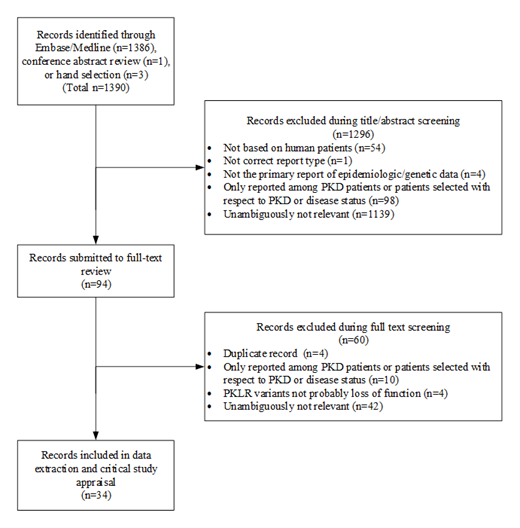Introduction:
Red cell pyruvate kinase deficiency (PKD) is a rare congenital disorder caused by compound heterozygosity or homozygosity for >300 mutations in the PKLR gene. The resulting glycolytic defect can lead to lifelong chronic hemolysis and associated symptoms, including anemia, jaundice, and iron overload. Reports of PKD prevalence vary, likely due to several factors, including PKD rarity, differences in measurement approaches, diagnostic challenges, and variable clinical expression. To understand the prevalence of PKD, we conducted a systematic literature review to identify and evaluate analyses of PKD epidemiology or PKLR mutant allele frequency (MAF).
Methods:
We queried Embase and Medline, screened conference abstracts, and considered relevant articles encountered incidentally to identify peer-reviewed references published before January 23, 2019 reporting PKD prevalence or incidence, PKLR MAF among the general population, or crude results from which prevalence, incidence or MAF could be derived. Two independent reviewers screened for eligibility and extracted data from eligible studies using a custom tool.
Results:
Of 1390 references screened, 1296 were excluded after title/abstract review (Figure). Of the remaining 94 references, 34 met eligibility criteria on full text review. In 30/34 eligible studies, potential sources of bias in PKD prevalence were identified, such as a non-generalizable study population (e.g., malaria-endemic areas; n=17), use of diagnostic assays of questionable accuracy (n=9), consideration of mutations with incomplete penetrance (n=3), and consideration of mutations with unclear clinical significance (n=1). The remaining 4 studies were considered high-quality for the estimation of PKD prevalence and were further assessed.
Among these 4 studies, an important distinction was made between studies reporting diagnosed prevalence (n=3) and overall disease prevalence (diagnosed and undiagnosed PKD; n=1). Two studies estimated diagnosed PKD prevalence as 3.2 per million[i] and 8.5 per million[ii] by identifying diagnosed PKD cases from source populations of known size. We estimated the prevalence of diagnosed PKD in a general population to be 6.5 per million using data from another high-quality study[iii] that screened newborns for bilirubin and tested jaundiced newborns for PKD. These 3 studies are likely underestimates because they only consider diagnosed cases, and in one study only diagnosed, jaundice cases.
In the final study,[iv] the authors sought to limit biases related to the Hardy-Weinberg equilibrium (HWE) assumption, as HWE incorrectly assumes the penetrance of each mutation is 100%. To address this, the authors identified a mutation known to have high penetrance (c.1529G>A), referred to as the 'index mutation'. They then assumed that the frequency of the index mutation relative to other PKD-causing mutations is the same between the general population and PKD cases, which led to a prevalence estimate (diagnosed and undiagnosed) of 51 per million (standard error: 32.5 per million).
Conclusions: We consider the likely range of diagnosed PKD prevalence in general Western populations to be 3.2 to 8.5 per million. However, diagnosed and undiagnosed PKD prevalence may be as high as 51 per million. Future studies are needed to understand the clinical significance of various mutant alleles, which may inform more accurate, clinically-relevant PKD prevalence estimates, identify the degree of and reasons for underdiagnosis, and elucidate PKD heterogeneity between populations.
References:
[i] Carey PJ, Chandler J, Hendrick A, Reid MM, Saunders PW, Tinegate H, Taylor PR, West N. Prevalence of pyruvate kinase deficiency in a northern European population in the north of England. Blood. 2000 Dec 1;96(12):4005-6.
[ii] de Medicis E, Ross P, Friedman R, Hume H, Marceau D, Milot M, Lyonnais J, de Braekeleer M. Hereditary nonspherocytic hemolytic anemia due to pyruvate kinase deficiency: a prevalence study in Quebec (Canada). Human heredity. 1992;42(3):179-83.
[iii] Christensen RD, Eggert LD, Baer VL, Smith KN. Pyruvate kinase deficiency as a cause of extreme hyperbilirubinemia in neonates from a polygamist community. Journal of Perinatology. 2010 Mar;30(3):233.
[iv] Beutler E, Gelbart T. Estimating the prevalence of pyruvate kinase deficiency from the gene frequency in the general white population. Blood. 2000 Jun 1;95(11):3585-8.
Storm:Agios: Employment. Secrest:Agios: Other: Received funds as part of contracted research; IQVIA: Employment. Carrington:Agios: Other: Received funds as part of contracted research; IQVIA: Employment. Gilroy:Agios: Employment. Pladson:Agios: Employment. Boscoe:Agios Pharmaceuticals, Inc.: Employment, Equity Ownership. Casso:IQVIA: Employment; Agios: Other: Received funds as part of contracted research.
Author notes
Asterisk with author names denotes non-ASH members.


This feature is available to Subscribers Only
Sign In or Create an Account Close Modal